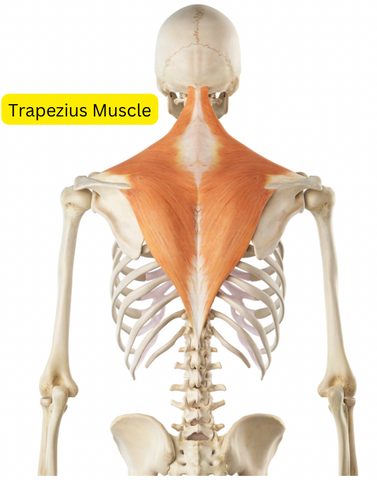
Have you ever felt a nagging spot of tightness on your trapezius muscle? Having tension anywhere in the body can be hard to ignore, not only making it difficult to have full range of motion but also hindering the possibility of reaching your peak performance.
Trigger points can pop up at seemingly random times in our lives, but have you wondered about what they are and how to manage them? On this page, we’ll investigate the ins and outs of trapezius trigger points and how to release them!
First, What is a Trigger Point?
According to a journal article published in BioMed Research International, trigger points are also known as Myofascial pain syndrome (MPS) and are defined as a focal hyperirritability in muscle tissue.
The specific area where you’ll feel it is usually one of referred pain (which we’ll cover later), may have a local twitch response, and is also called a myofascial trigger point. Typically you’ll be able to palpate the area where the knot is located, feeling the taught band of muscle or fascia that is causing it.
Myofascial trigger points of the trapezius can present as pain in the following locations:
- Neck
- Shoulders
- Connecting area of the arms
Symptoms also include:
- Headache
- Limited movement of upper (cervical) spine
- Dizziness [1]
Where is Your Trapezius?
The trapezius is a superficial, triangular (or trapezoid-shaped) muscle that spans your upper back and neck area. It extends from the bottom of your skull, down the spine to the middle of the back, and out to your shoulders - as it connects your arms to your skull and vertebrae.

Roles of the trapezius:
- Movement of shoulder blades and neck (shrugging, rotating, retracting)
- Extending and flexing of the neck [1]
- Assists in posture (supporting spinal column when standing)
- Elevates, depresses, and retracts the scapula
- Internally rotates arms [2]
The function of the trapezius was awesomely described in a text as being similar to a large construction crane, “The giant arm is the most obvious feature of the crane, but the jacks that anchor the cab of the crane to the ground are essential to its stability. Without these muscles, the upper limb (the arm of the crane) would be useless.” [2]
Because of its expansive role - you’d probably feel any trigger points in this area whenever using your upper body!
What Causes Trapezius Trigger Points?
Just like trigger points that emerge in other parts of the body, there are some common root causes behind them. Some of these include:
- Poor posture (such as forward head posture or abnormal scapula alignment [4])
- Overuse
- Stress - leading to muscle tension
- Injury
In terms of overuse, according to a study published in the Journal of Human Kinetics, athletes in the following sports perform rapid, repetitive overhead movements putting them at higher risk of shoulder injuries and causing excessive stress on these muscles:
- Baseball
- Badminton
- Tennis
- Swimming
- Volleyball [3]
This same study also reports, “The most common location of myofascial trigger points is the upper trapezius, with 78.8% of healthy people having latent trigger points.” [3]
How to Release Trapezius Trigger Points
If you effectively release any trigger points (muscle knots or tight muscles), you’ll know it because you’ll experience noticeable pain relief. Luckily, trigger point therapy is something you can learn to do on your own.
By using focused deep tissue massage, you can release these trigger points - but you must first find the knot and also use the correct tool to do the job.
Aside from using your own hands, fingers, knuckles, elbows, etc. knowing how to do a lacrosse ball massage (a tennis ball would work too) would come in handy. This particular technique is useful for upper back tension, and you will need a wall, a ball, and your bodyweight to apply the tension. Check out the page for how to do a lacrosse ball massage.

If you’d like to tackle a trigger point massage today, mosey on over to this page for more in-depth instructions.
Keep in mind that there are times when trigger point massage shouldn’t be used and remember to consult your healthcare provider for any advice on the matter.
Trapezius Trigger Points: What is Referred Pain?
Referred pain is when pain is felt in a different part of the body from its actual source - Wherever you feel the pain may not be where it’s coming from. This can be the case when it comes to trigger points.
As noted earlier, trapezius trigger points can cause referred pain in areas of the neck and head, which can limit your movement and even cause headaches. If pain is severe enough, sometimes pain can travel to the eye or jaw as well.
Trapezius Trigger Points FAQ
How do you release trigger points in your trapezius?
You can release trigger points in your trapezius by successfully finding the knots/area of tension and performing deep tissue massage.
Is there a pressure point for the trapezius muscle?
Yes, there are pressure points for the trapezius muscle. It must be noted, however, that trigger points and pressure points are related but not the same.
Since we’ve reviewed that pressure points are essentially muscle knots, pressure points are areas that correspond to organs or systems - and when pressure is applied can produce therapeutic effects.
To fight tech neck or turtle neck syndrome, a pressure point does exist at the most top area of the shoulder within the upper trapezius.
How do you get rid of trapezius knots?
See the first question.
What is the best way to loosen trapezius muscles?
The best way to loosen trapezius muscles would be a combination of stretching, self-massage, and relaxation/self-care. Some examples include:
- Neck and shoulder stretches (head tilts or rotations)
- Lacrosse/tennis ball massage
- Deep tissue massage
- Heat therapy
- Correct posture
- Reduce stress
Trapezius Trigger Points: Key Takeaways
Trapezius trigger points can certainly cause significant discomfort and ultimately impact your daily activities. Keep in mind all the risk factors noted on this page to make sure you can steer clear of tension in your trapezius muscles!
Although you may be able to tackle the tension, remember that ongoing maintenance requires lifestyle change and body awareness. Even if you can get rid of a knot, they can easily return if you fall back to your old ways. Try to stay stress-free and keep those traps loose!
Sources:
[1] Akamatsu, F., Ayres, B., Saleh, S., Hojaij, F., Andrade, M., Hsing, W., Jacomo, A. Trigger points: an anatomical substratum. BioMed Research International, 2015
[2] Ourieff, J., Scheckel, B., Agarwal, A. Anatomy, back, trapezius. StatPearls, 2023.
[3] Huang, L., Huang, T., Lin, Y., Huang, C., Yang, J., Lin, J. Effects of upper trapezius myofascial trigger points on scapular kinematics and muscle activation in overhead athletes. Journal of Human Kinetics, 2022.
[4] Ui-Jae, H., Oh-Yun, K., Chung-Hwi, Y., Hye-Seon, J., Hyuck, J., Sung-Min, S. Predictors of upper trapezius pain with myofascial trigger points in food service workers. Medicine, 2017.


